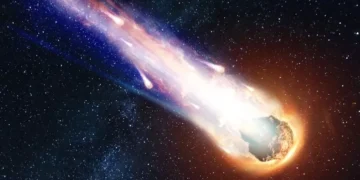The discovery of the S2 meteor impact, occurring around 3.26 billion years ago, provides a fascinating window into Earth’s early evolutionary dynamics. This article explores how this colossal impact, estimated to be the size of four Mount Everests, fundamentally reshaped the oceanic environment, introducing elements like iron and phosphorus. These nutrients supported the growth of primitive bacteria, potentially kickstarting the evolution of complex life.
The Impact Event: A Catastrophic Force with Creative Consequences
The S2 impact, as researchers call it, was no ordinary collision. Striking with a force nearly 200 times greater than the asteroid that wiped out the dinosaurs, it profoundly transformed Earth’s environment. This meteorite struck the ancient oceans, causing massive tsunamis and sending immense amounts of heat and debris into the atmosphere. This extreme event stirred up ocean waters, bringing vital nutrients from the depths to the surface.
This collision created a scenario where Earth’s early seas were enriched with essential elements. The heat generated boiled away the ocean’s upper layers, while the impact churned up iron from the seabed. At the same time, phosphorus, an element crucial for life, was introduced through the meteorite itself.
Evidence from the Barberton Greenstone Belt: Tracing Earth’s Ancient Past
To understand the long-term effects of the S2 impact, Drabon and her team studied ancient rocks in South Africa’s Barberton Greenstone Belt. This region holds some of the oldest geological records on Earth, allowing scientists to uncover evidence from over 3 billion years ago.
Their findings suggest that the S2 impact played a crucial role in altering ocean chemistry. Elements like iron and phosphorus, both of which are vital for cellular processes in life forms, were suddenly more abundant in the water. This change is believed to have led to a surge in microbial life, especially iron-metabolizing bacteria, which thrived in the altered conditions.
A New Perspective on Mass Extinctions and Evolutionary Catalysts
Meteor impacts are often associated with destruction—end-of-the-world scenarios like the one that led to the demise of the dinosaurs. However, the S2 impact presents a different narrative. Instead of solely causing devastation, this event may have acted as a catalyst for life.
Drabon’s research challenges the conventional view that impacts are purely destructive, offering a more nuanced understanding. While the initial conditions might have been inhospitable, the long-term results could have been a boon for evolution. This perspective reshapes how scientists view other significant impact events in Earth’s history, potentially redefining the role of extraterrestrial collisions in the broader narrative of life’s origins.
Why Understanding the S2 Impact Matters Today
The implications of this discovery extend beyond Earth’s ancient history. Understanding how such events influence life’s potential helps scientists assess the habitability of other planets. For example, studying Mars or icy moons like Europa often involves looking for similar chemical changes that could support life.
Moreover, this research emphasizes the resilience of life. If simple microbial life could survive and even flourish under such extreme conditions billions of years ago, it suggests that life elsewhere in the universe could be more adaptable than previously thought.
Future Research Directions: Uncovering More Ancient Impacts
Drabon’s team has only scratched the surface of what the Barberton Greenstone Belt can reveal. With evidence of seven other significant meteor impacts in this region, future research could further illuminate the role of such events in shaping Earth’s early biosphere.
The prospect of finding more about how these ancient impacts influenced life’s trajectory is both thrilling and essential. By continuing to explore these geological time capsules, scientists hope to unlock more secrets of Earth’s past, which could inform our understanding of planetary evolution and the emergence of life across the universe.
Conclusion: Rethinking Earth’s Origins and the Role of Catastrophe
The story of the S2 meteor impact is a reminder that the history of life on Earth is full of unexpected twists. What initially appears to be a tale of devastation reveals itself as a story of resilience and opportunity. This research not only deepens our understanding of Earth’s past but also opens up new possibilities for how life could arise under extreme conditions elsewhere in the cosmos.
Reference:
Koeberl, C., Schulz, T., & Huber, M. S. Precambrian impact structures and ejecta on earth: A review.



















